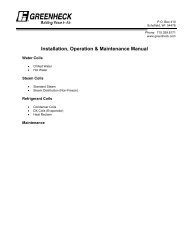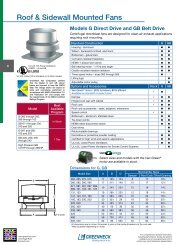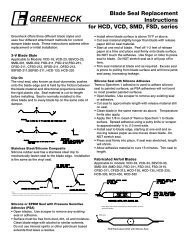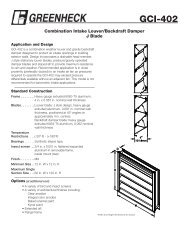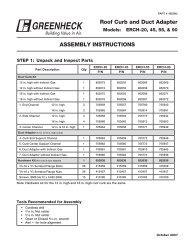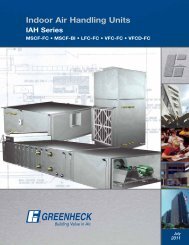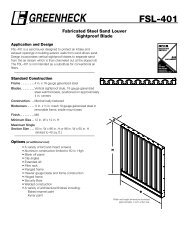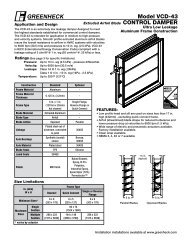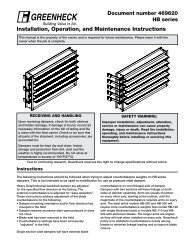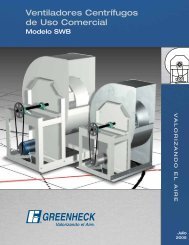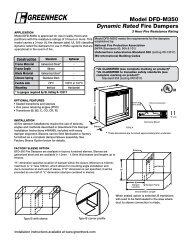Vektor-CD Performance Catalog - Greenheck
Vektor-CD Performance Catalog - Greenheck
Vektor-CD Performance Catalog - Greenheck
Create successful ePaper yourself
Turn your PDF publications into a flip-book with our unique Google optimized e-Paper software.
<strong>Vektor</strong>-<strong>CD</strong> Selection: Fan Curves<br />
Every laboratory or fume exhaust application has a unique set of criteria that must be evaluated in order to<br />
determine the most effective exhaust system. The selection of a <strong>Vektor</strong>-<strong>CD</strong> requires the total lab exhaust volume<br />
(effluent) per fan along with a determination of the external static pressure. Other considerations when making<br />
fan selections include: sound requirements, electrical limitations, size constraints, and the effective plume rise.<br />
1) Determine the laboratory exhaust requirements<br />
• Determine the total lab exhaust volume<br />
(effluent) per fan.<br />
• Determine the external static pressure entering<br />
the fan system.<br />
Bypass Air Plenums - Estimated Pressure Drop<br />
• Variable volume lab exhaust systems and<br />
systems adding dilution air require a bypass air<br />
plenum and damper.<br />
• <strong>Greenheck</strong>’s computer aided product selection<br />
software (CAPS), automatically adds external<br />
system static pressure to account for the<br />
bypass air plenum and isolation damper.<br />
2) Select the appropriate <strong>Vektor</strong>-<strong>CD</strong><br />
A Select <strong>Vektor</strong>-<strong>CD</strong> fans with a minimum<br />
nozzle velocity of 3,000 feet per minute<br />
(ANSI Z9.5 and ASHRAE lab design<br />
guidelines), which is represented by the<br />
green vertical line in Figure 1.<br />
• All <strong>Vektor</strong>-<strong>CD</strong> curves indicate the<br />
minimum cfm necessary to meet this<br />
minimum velocity.<br />
3) Determine fan rpm<br />
• Locate the fan operating point (the intersection<br />
of the required airflow and static pressure) on<br />
the performance curve in Figure 1.<br />
In this example, the operating point is<br />
B<br />
17,000 cfm at 4 in. wg.<br />
The belt drive fan rpm can be estimated by<br />
comparing the operating point to any of the<br />
solid fan rpm curves and in this example, the<br />
operating point falls on the red 1734 rpm curve.<br />
Direct drive fan selections must use the 50 or<br />
C<br />
60 cycle rpm curves (yellow or blue curves).<br />
• Determine the brake horsepower by comparing<br />
the operating point to the dashed brake<br />
horsepower curves.<br />
In this example, the brake horsepower is above<br />
20, but slightly less than 30 hp. A minimum of a<br />
30 hp motor is recommended for this selection.<br />
4) LV, MV and HV Nozzles<br />
D Each fan size is available with Low Velocity<br />
(LV), Medium Velocity (MV), or High<br />
Velocity (HV) nozzles.<br />
• Multiple nozzles (VNT) allow for the optimization<br />
of brake horsepower, plume rise and<br />
acoustic performance.<br />
Note: For most applications, the LV or MV nozzles are<br />
recommended in order to limit the operating brake<br />
horsepower. HV nozzles are available for applications<br />
that require the highest plume rise.<br />
16<br />
VEKTOR<strong>CD</strong>-30HV<br />
Figure 1: <strong>Vektor</strong>-<strong>CD</strong> Size 30 High Velocity<br />
A<br />
60% WOV<br />
50 Cycle RPM<br />
60 Cycle RPM<br />
C<br />
35<br />
14<br />
70% WOV<br />
Static Pressure (Pa x 100)<br />
30<br />
25<br />
20<br />
15<br />
10<br />
5<br />
0<br />
Static Pressure (in. wg)<br />
RPM<br />
HP<br />
WOV<br />
Density 0.075<br />
12<br />
10<br />
8<br />
6<br />
4<br />
2<br />
720<br />
870<br />
950<br />
MAX RESISTANCE CURVE<br />
2 hp<br />
1170<br />
5 hp<br />
1450<br />
7½ hp<br />
10 hp<br />
1734<br />
1900<br />
15 hp<br />
2050<br />
25 hp<br />
20 hp<br />
0<br />
0 4 8 12 16 20 24 28 32<br />
Volume (cfm x 1000)<br />
80% WOV<br />
90% WOV<br />
0 10 20 30 40 50<br />
Volume (m 3 /hr x 1000)<br />
2182<br />
30 hp<br />
40 hp<br />
50 hp<br />
60 hp<br />
B<br />
100% Wheel Width<br />
Windband<br />
Outlet Area<br />
Class II Fan<br />
Max rpm<br />
Class III Fan<br />
Max rpm<br />
<strong>Performance</strong><br />
Data<br />
= 8.3 ft 2 Nozzle Velocity<br />
{ft/min}<br />
= 1734<br />
= 2182<br />
Effective Plume @ 10 mph Crosswind<br />
Height {ft}<br />
(3 * Windband Outlet Volume * 0.392)<br />
880<br />
+ 11.50<br />
% WOV<br />
3000 fpm: Inlet<br />
Airflow Rate<br />
D<br />
LV MV HV<br />
Fan cfm Fan cfm Fan cfm<br />
4.35 ft 2 3.48 ft 2 2.61 ft 2<br />
cfm x 100<br />
rpm x 14.3<br />
cfm x 100<br />
rpm x 13.6<br />
cfm x 100<br />
rpm x 12.2<br />
13050 cfm 10440 cfm 7830 cfm<br />
10




